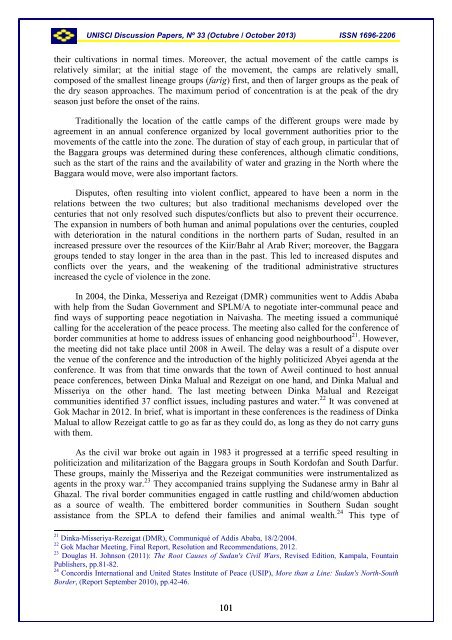UNISCI - Universidad Complutense de Madrid
UNISCI - Universidad Complutense de Madrid
UNISCI - Universidad Complutense de Madrid
Create successful ePaper yourself
Turn your PDF publications into a flip-book with our unique Google optimized e-Paper software.
<strong>UNISCI</strong> Discussion Papers, Nº 33 (Octubre / October 2013) ISSN 1696-2206their cultivations in normal times. Moreover, the actual movement of the cattle camps isrelatively similar; at the initial stage of the movement, the camps are relatively small,composed of the smallest lineage groups (farig) first, and then of larger groups as the peak ofthe dry season approaches. The maximum period of concentration is at the peak of the dryseason just before the onset of the rains.Traditionally the location of the cattle camps of the different groups were ma<strong>de</strong> byagreement in an annual conference organized by local government authorities prior to themovements of the cattle into the zone. The duration of stay of each group, in particular that ofthe Baggara groups was <strong>de</strong>termined during these conferences, although climatic conditions,such as the start of the rains and the availability of water and grazing in the North where theBaggara would move, were also important factors.Disputes, often resulting into violent conflict, appeared to have been a norm in therelations between the two cultures; but also traditional mechanisms <strong>de</strong>veloped over thecenturies that not only resolved such disputes/conflicts but also to prevent their occurrence.The expansion in numbers of both human and animal populations over the centuries, coupledwith <strong>de</strong>terioration in the natural conditions in the northern parts of Sudan, resulted in anincreased pressure over the resources of the Kiir/Bahr al Arab River; moreover, the Baggaragroups ten<strong>de</strong>d to stay longer in the area than in the past. This led to increased disputes andconflicts over the years, and the weakening of the traditional administrative structuresincreased the cycle of violence in the zone.In 2004, the Dinka, Messeriya and Rezeigat (DMR) communities went to Addis Ababawith help from the Sudan Government and SPLM/A to negotiate inter-communal peace andfind ways of supporting peace negotiation in Naivasha. The meeting issued a communiquécalling for the acceleration of the peace process. The meeting also called for the conference ofbor<strong>de</strong>r communities at home to address issues of enhancing good neighbourhood 21 . However,the meeting did not take place until 2008 in Aweil. The <strong>de</strong>lay was a result of a dispute overthe venue of the conference and the introduction of the highly politicized Abyei agenda at theconference. It was from that time onwards that the town of Aweil continued to host annualpeace conferences, between Dinka Malual and Rezeigat on one hand, and Dinka Malual andMisseriya on the other hand. The last meeting between Dinka Malual and Rezeigatcommunities i<strong>de</strong>ntified 37 conflict issues, including pastures and water. 22 It was convened atGok Machar in 2012. In brief, what is important in these conferences is the readiness of DinkaMalual to allow Rezeigat cattle to go as far as they could do, as long as they do not carry gunswith them.As the civil war broke out again in 1983 it progressed at a terrific speed resulting inpoliticization and militarization of the Baggara groups in South Kordofan and South Darfur.These groups, mainly the Misseriya and the Rezeigat communities were instrumentalized asagents in the proxy war. 23 They accompanied trains supplying the Sudanese army in Bahr alGhazal. The rival bor<strong>de</strong>r communities engaged in cattle rustling and child/women abductionas a source of wealth. The embittered bor<strong>de</strong>r communities in Southern Sudan soughtassistance from the SPLA to <strong>de</strong>fend their families and animal wealth. 24 This type of21 Dinka-Misseriya-Rezeigat (DMR), Communiqué of Addis Ababa, 18/2/2004.22 Gok Machar Meeting, Final Report, Resolution and Recommendations, 2012.23 Douglas H. Johnson (2011): The Root Causes of Sudan's Civil Wars, Revised Edition, Kampala, FountainPublishers, pp.81-82.24 Concordis International and United States Institute of Peace (USIP), More than a Line: Sudan's North-SouthBor<strong>de</strong>r, (Report September 2010), pp.42-46.101
















